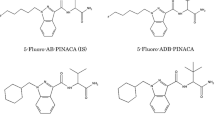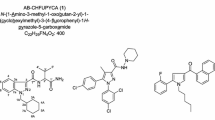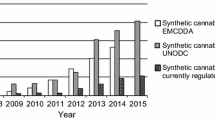Abstract
During our continual surveillance of unregulated drugs in May–June 2011, we found two new compounds as adulterants in herbal products obtained at shops in the Tokyo area. These compounds were identified by liquid chromatography–mass spectrometry, gas chromatography–mass spectrometry, accurate mass spectrometry, and nuclear magnetic resonance spectroscopy. The first compound identified was a naphthoylindole (1-(5-hydroxypentyl)-1H-indol-3-yl)(naphthalen-1-yl)methanone (AM-2202, 1), which is a side-chain hydroxyl analogue of JWH-018. The second compound was (1-(4-pentenyl)-1H-indol-3-yl)(naphthalen-1-yl)methanone (2), which is side-chain double bond analogue of JWH-018. This is the first report to identify 1 and 2 in a commercial “herbal” product to our knowledge. For quantitation of the above compounds 1 and 2, and chemical analysis for previously reported compounds (AM-2201, 3; JWH-203, 4; JWH-019, 7; JWH-210, 8; mitragynine, 9), each product was extracted with methanol under ultrasonication to prepare solutions for analysis by liquid chromatography with ultraviolet detection. For the sake of identifying JWH-203 (4) and its positional isomers [JWH-203-3-chloroisomer (5) and 4-chloroisomer (6)] correctly, simultaneous liquid chromatography analysis on fluorocarbon-bonded silica gel column was performed. And a case report of commercially available products containing synthetic cannabinoids 7 and 8, and a natural occurring alkaloid 9, was also shown. Each of 6 commercially circulated products contained compounds 1–4 and 7–9; the amounts of the compounds ranged from 4.1 to 222 mg per pack.








Similar content being viewed by others
References
Uchiyama N, Kikura-Hanajiri R, Kawahara N, Haishima Y, Goda Y (2009) Identification of a cannabinoid analog as a new type of designer drug in a herbal product. Chem Pharm Bull 57:439–441
Uchiyama N, Kikura-Hanajiri R, Kawahara N, Goda Y (2009) Identification of a cannabimimetic indole as a designer drug in a herbal product. Forensic Toxicol 27:61–66
Kikura-Hanajiri R, Kawamura M, Maruyama T, Kitajima M, Takayama M, Goda Y (2009) Simultaneous analysis of mitragynine, 7-hydroxymitragynine, and other alkaloids in the psychotropic plant “kratom” (Mitragyna speciosa) by LC–ESI–MS. Forensic Toxicol 27:67–74
Kikuchi H, Uchiyama N, Ogata J, Kikura-Hanajiri R, Goda Y (2010) Chemical constituents and DNA sequence analysis of a psychotropic herbal product. Forensic Toxicol 28:77–83
Uchiyama N, Kawamura M, Kikura-Hanajiri R, Goda Y (2011) Identification and quantitation of two cannabimimetic phenylacetylindoles JWH-251 and JWH-250, and four cannabimimetic naphthoylindoles JWH-081, JWH-015, JWH-200, and JWH-073 as designer drugs in illegal products. Forensic Toxicol 29:25–37
Nakajima J, Takahashi M, Seto T, Suzuki J (2011) Identification and quantitation of cannabimimetic compound JWH-250 as an adulterant in products obtained via the Internet. Forensic Toxicol 29:51–55
Nakajima J, Takahashi M, Seto T, Kanai C, Suzuki J, Yoshida M, Hamano T (2011) Identification and quantitation of two benzoylindoles AM-694 and (4-methoxyphenyl)(1-pentyl-1H-indol-3-yl)methanone, and three cannabimimetic naphthoylindoles JWH-210, JWH-122, and JWH-019 as adulterants in illegal products obtained via the Internet. Forensic Toxicol 29:95–110
Nakajima J, Takahashi M, Nonaka R, Seto T, Suzuki J, Yoshida M, Kanai C, Hamano T (2011) Identification and quantitation of a benzoylindole (2-methoxyphenyl)(1-pentyl-1H-indol-3-yl)methanone and a naphthoylindole 1-(5-fluoropentyl)-1H-indol-3-yl)-(naphthalene-1-yl)methanone (AM-2201) found in illegal products obtained via the Internet and their cannabimimetic effects evaluated by in vitro [35S]GTPγS binding assays. Forensic Toxicol 29:132–141
EMCDDA (2010) Europol 2010 Annual Report on the implementation of Council Decision. http://www.emcdda.europa.eu/attachements.cfm/att_132857_EN_EMCDDA-Europol%20Annual%20Report%202010A.pdf. Accessed Sept 2011
Ministry of Health, Labour and Welfare of Japan (2011). http://wwwhourei.mhlw.go.jp/hourei/doc/tsuchi/T110921I0010.pdf. Accessed 22 Sept 2011
Bononi M, Belgi P, Tateo F (2011) Analytical data for identification of the cannabimimetic phenylacetylindole JWH-203. J Anal Toxicol 35:360–363
Kitajima M, Misawa K, Kogure N, Said Ikram M, Horie S, Hatori Y, Murayama T, Takayama H (2006) A new indole alkaloid, 7-hydroxyspeciociliatine, from the fruits of Malaysian Mitragyna speciosa and its opioid agonistic activity. J Nat Med 60:28–35
Makriyannis A, Deng H (2008) Cannabimimetic indole derivatives, United States Patent, US 0090871 A1
Brents Lisa K, Reichard Emily E, Zimmerman Sarah M, Moran Jeffery H, Fantegrossi William E, Prather Paul L (2011) Phase I hydroxylated metabolites of the K2 synthetic cannabinoid JWH-018 retain in vitro and in vivo cannabinoid 1 receptor affinity and activity. PLoS ONE 6(7): e21917. doi:10.1371/journal.pone.0021917
Wiley JL, Compton DR, Dai D, Lainton JA, Phillips M, Huffman JW, Martin BR (1998) Structure-activity relationships of indole and pyrrole-derived cannabinoids. J Pharmacol Exp Ther 285:995–1004
Monde T, Kamisuki T, Kuroda T, Mikumo K, Ohkawa T, Fukube H (1996) High-performance liquid chromatographic separation of phenols on a fluorocarbon-bonded silica gel column. J Chromatogr A 722:273–280
Holler JM, Vorce SP, McDonough-Bender PC, Magluilo J Jr, Solomon CJ, Levine B (2011) A drug toxicity death involving propylhexedrine and mitragynine. J Anal Toxicol 35(1):54–59
EMCDDA (2009) Thematic papers: understanding the “Spice” phenomenon. http://www.emcdda.europa.eu/attachements.cfm/att_80086_EN_Spice%20Thematic%20paper%20-%20final%20version.pdf. Accessed Oct 2011
Author information
Authors and Affiliations
Corresponding author
Rights and permissions
About this article
Cite this article
Nakajima, J., Takahashi, M., Seto, T. et al. Identification and quantitation of two new naphthoylindole drugs-of-abuse, (1-(5-hydroxypentyl)-1H-indol-3-yl)(naphthalen-1-yl)methanone (AM-2202) and (1-(4-pentenyl)-1H-indol-3-yl)(naphthalen-1-yl)methanone, with other synthetic cannabinoids in unregulated “herbal” products circulated in the Tokyo area. Forensic Toxicol 30, 33–44 (2012). https://doi.org/10.1007/s11419-011-0130-5
Received:
Accepted:
Published:
Issue Date:
DOI: https://doi.org/10.1007/s11419-011-0130-5




